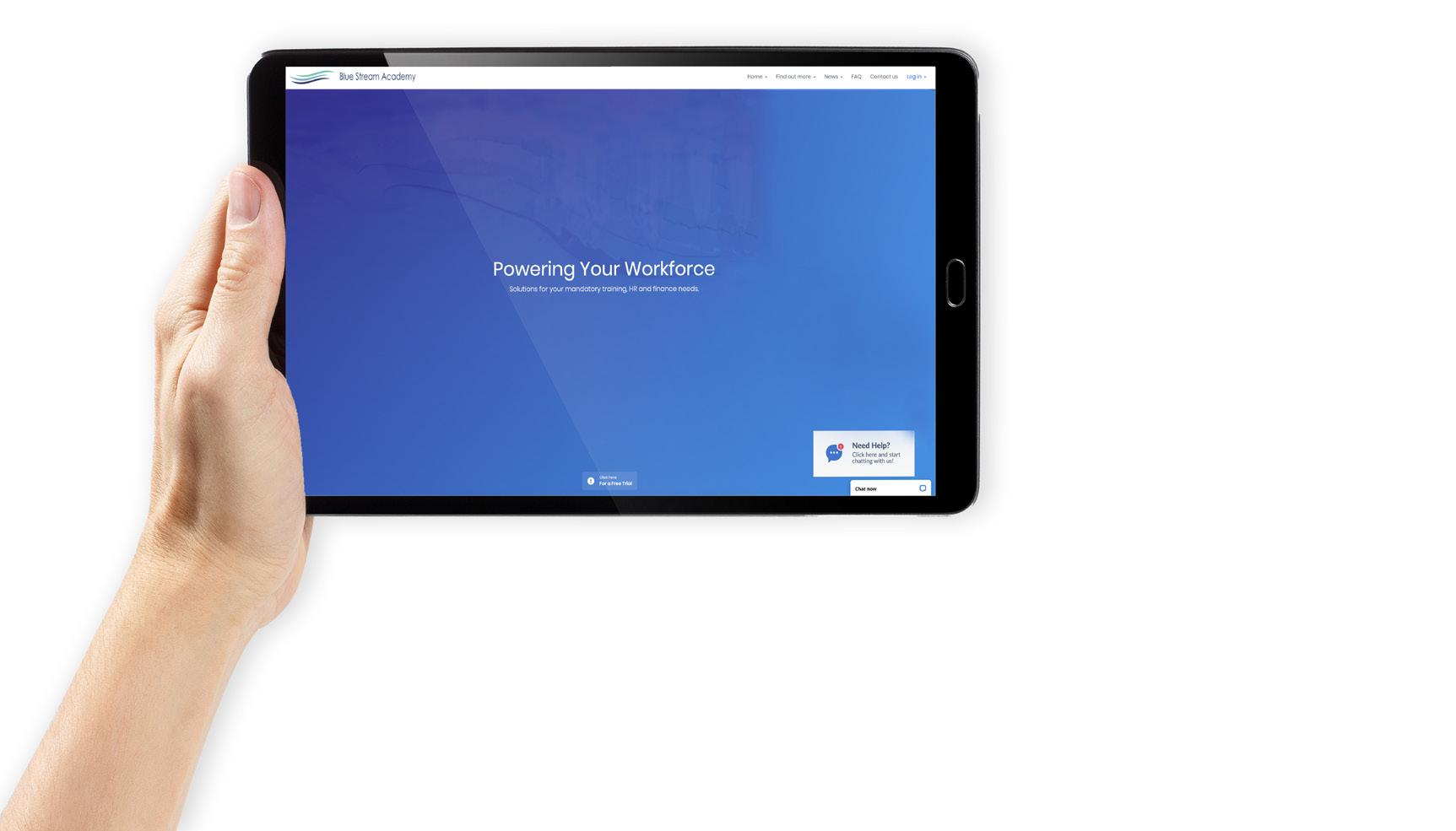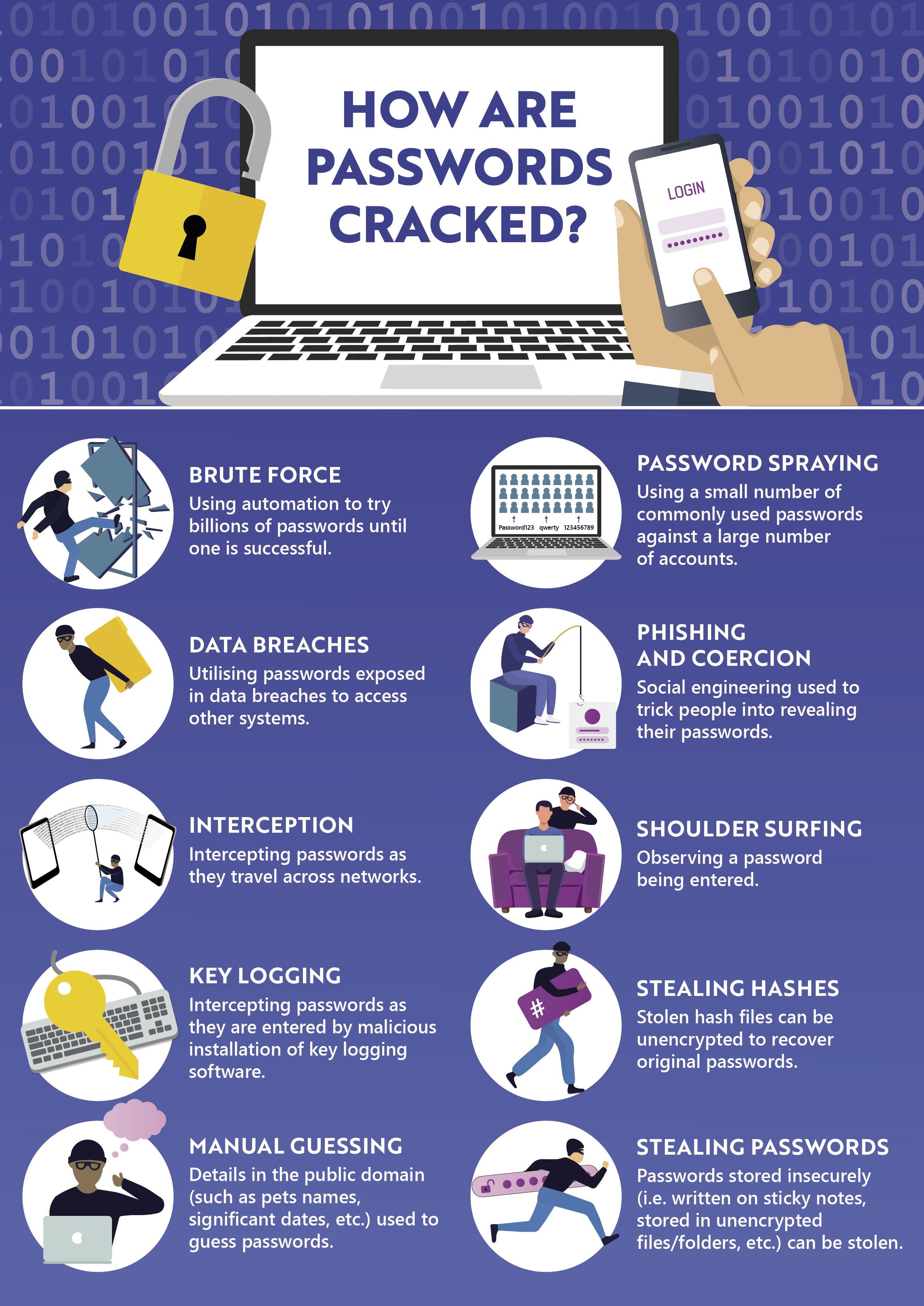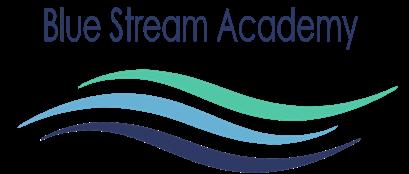
Today BSABlue Stream Academy’s Healthcare & Lifestyle Magazine Autumn 2022 | Issue 15 Menopause in the Workplace Dr Toni Hazell Look Who’s Talking: CQC Ratings: The Good, the Bad and the Outstanding Richard Banyard 2-Minute Clinic: Questions You’re Afraid to Ask a GP Dr Roger Henderson
BSA Today is the exciting healthcare & lifestyle magazine from Blue Stream Academy - the UK’s leading provider of online training for GP Practices, Nursing & Care Homes, Hospices, Urgent and Tailored Care Centres and Aesthetic Clinics.

Our mission is to standardise healthcare training to ensure consistent delivery of quality care through better staff education, learning and development.
Providing over 100 hours of CPD-certified eLearning, Blue Stream Academy’s suite of interactive training modules is easy to use, cost-effective and in line with CQC guidelines.
If you have any comments, suggestions or ideas for future articles, please feel free to contact our editor, Brady Braddock, by email: brady@bluestreamacademy.com

Alternatively, you can write to us, phone us, or visit our website:
Blue Stream Academy
Suites 11, 12, 15 & 16
Riverside Business Centre
Foundry Lane
0RN
822549
Disclaimer:
The views and opinions expressed within this publication are that of the original authors of the relevant content and do not necessarily reflect the official views and opinions of Blue Stream Academy Ltd.
TBSA
SUBSCRIBE
Would you like to join our Subscribers’ Club to receive future issues of BSA Today before anyone else? Plus, gain access to our exclusive prize draws and competitions?

If so, you can join today at bluestreamacademy.com/subscribe
Alternatively, you can phone us on 01773 822549 or drop us an email at bsatoday@bluestreamacademy.com

Milford Derbyshire DE56
01773
bluestreamacademy.com
© 2022 Blue Stream Academy
oday 02 BSA Today Issue 15 Front Cover
In this issue
From the Editor's Desk...
With the nights getting longer and the leaves starting to change, it looks like autumn has now arrived – and so has the latest issue of BSA Today! With the coming of the new season, there are plenty of reasons to be optimistic.



One of the best things about life is that we never stop learning. In fact, you can learn something new every day if you pay attention – a philosophy that can be adopted by anyone at any stage of life, often with amazing results.
After each issue goes out, the team and I get together for a debrief and a discussion about the direction of the next issue. We’re always delighted to hear from readers who have taken time out of their busy schedules to provide feedback.
This interaction fuels our desire for excellence and progression, as we have made it our mission to educate and enlighten our readers with every article we publish.
On behalf of everyone here at Blue Stream Academy, we hope you enjoy reading Issue 15 of BSA Today!
Brady
Brady Braddock BSA Today Editor
Expert Panel
Meet the experts who have contributed their knowledge and insight to this issue of BSA Today

Richard Banyard


at CQCassist
Dr
Dr Roger Henderson

Our Team
EDITORIAL
Brady Braddock
Lewis Cowlishaw
Alex Burnell
Stuart Walsh
Editor
Content Development Lead
Development
Information Security
ART & DESIGN
Courteney
Craig
COMMUNICATIONS
Abi
Caitlin Wood
Services
& Media
Assistant
03www.bluestreamacademy.com
BSA Today | Issue 15
|
|
| Content
|
Barlow-Ferguson | Graphic Designer
Goodall | Creative
Bowler | Marketing
| Marketing
Director
Senior GP, Media Advisor and Health Writer
Toni Hazell GP, Freelance Medical Writer, Blogger and Editor
Cover Stories
15 CQC Ratings: The Good, the Bad and the Outstanding
Are you ready for your next CQC inspection? Some themes and issues have been attracting particular attention recently. Here, Richard Banyard from CQCassist has his say on a hugely important topic.
26 2-Minute Clinic: Questions
You’re Afraid to Ask a GP
During a GP appointment, it’s especially important to ask questions – although some of us find this more challenging than others. Senior GP, media advisor and health writer Dr Roger Henderson responds to a series of questions that many people are afraid or embarrassed to ask a GP.
06
All Things Blue Stream

06 Eye on Healthcare
Showcasing cutting-edge academic content from The Conversation, we keep you up to date with hot topics from across health and social care, written by professionals who share a passion for reporting on the issues that matter most.
10 A Spotlight On... Chaperoning
Trusted training at your fingertips! In the latest of our ‘Spotlight On…’ series, we give readers a closer look at some of Blue Stream Academy’s interactive training modules. In this issue, we shine the spotlight on chaperoning.
24 HR Hub: Increasing Employee Engagement

We explore some of the best ways to keep employees engaged during the ‘Great Resignation’, focusing on the importance of wellbeing, communication and why we should always recognise each other’s achievements, no matter how big or small.
29 Datawatch: The Fundamentals of Password Management
A single weak or compromised password can have a huge effect on an organisation’s operations, potentially interfering with critical systems, disrupting networks and disclosing sensitive data. Here, we discuss some of the principles of effective password management.
42 @BlueStreamNews
We recap the last few months at Blue Stream Academy and talk news and events with #TeamBSA. Plus, we have some key dates for your autumn diary.

43 LiveChat Lounge
We check in with Blue Stream Academy’s friendly support team to hear what our customers have asked them about our suite of interactive training modules and Management of Information System (MIS).
04
Lifestyle & Wellness
34 Wellness Workshop: Top Tips to Declutter Your Life

Organisation is the key to being punctual, meeting deadlines and managing your work-life balance. In the first instalment of our Wellness Workshop series, health sciences and medical writer Bethany Cooper presents her practical tips for co-ordinating your home and your life to improve your mood and your state of mind.

38 Great Food with Two Greedy Gals

Two Greedy Gals are back with their seasonal favourites. From a warming tomato and roasted red pepper soup to a mouth-watering apple and blackberry pie, we’ve got everything you’ll need for those chilly autumnal evenings!
10
Look Who’s Talking
Menopause in the Workplace

The menopause is often seen as a sensitive and private topic, especially in the workplace. Here, Dr Toni Hazell, GP, freelance medical writer and regular BSA Today contributor, explains what employers can do to help women at work who are going through the menopause.



www.bluestreamacademy.com 05 38
20
26 34 15
Wellness Vapes: What You Need to Know About Vaping Vitamins and Other Supplements
So-called wellness vapes are growing in popularity. [1]
Unlike regular vapes (e-cigarettes) that contain nicotine, these products contain vitamins, hormones or essential oils. But they have caught the attention of the US Food and Drug Administration (FDA) because of the unproven health claims made by many of the companies that sell them.
Wellness vapes – also known as “nutritional supplement diffusers” –cover a range of products that find a common origin in e-cigarettes.

E-cigarettes deliver nicotine to the lungs without the need for combustion or tobacco. This removes some harmful components, such as tobacco tar. Instead of combustion, e-cigarettes

use energy from a battery to heat e-liquid, which forms a vapour that can be inhaled. A new wave of products aims to use this same inhaled delivery system for a wide range of non-nicotine products, including vitamins (B12 and C are particularly popular), milk thistle, melatonin (a hormone), green tea and a variety of essential oils.
Wellness vape companies make claims that different combinations of these additives can help you focus better, promote sleep and even help you lose weight.
Inhaling rather than swallowing these compounds results in faster absorption into the bloodstream, so, theoretically, the vitamins and supplements could act faster when inhaled.
Many of these additives will be individually familiar as supplements that are rated as safe for ingestion.
06
But the vast majority lack inhalation safety testing, particularly of potential long-term harms. Because wellness vapes don’t contain nicotine, they evade the regulators.
The incidence of e-cigarette-related acute lung injury (Evali) in the US[2] in 2019 highlights the importance of testing the route of intake. In the 60 deaths from Evali initially reported, vitamin E acetate was identified as a key agent that caused lung damage in these people. Vitamin E is a common food additive, so this clearly highlights how even wellknown substances can have very serious health consequences when inhaled.
These devices are quite new to the market, so there is little research on their safety. However, we can consider the specific components to look for potential effects, whether beneficial or harmful.


E-liquid Components
Many benign or beneficial compounds can become harmful if given in an untested way or given to the wrong patient group.
For example, the benefits of vitamin C are universally known, yet the use of high-dose vitamin C has been shown to increase the risk of death in people with sepsis.[3]
Vitamin B12 is also a popular additive for these devices. In people who are deficient in the vitamin, a B12 injection is very effective in restoring levels. Yet there is a distinct lack of supporting evidence for any benefits to people with normal B12 levels. Also, we lack evidence on the safety or effectiveness of inhaled B12.
One study carried out in 1967 showed no benefit to inhaling vitamin B12 over supplementation by injection. But even in 1967, the researchers were careful to point out the potential for lung damage.
We can also look at information from shared components with e-cigarettes to look for potential effects. Some products deliver vitamin B12 dissolved in a common e-liquid component, vegetable glycerine.
Continued on Page 08
Authors
Aaron Scott Asscoiate Professor in Respiratory Science, University of Birmingham
Postdoctoral Research Fellow, Inflammation and Ageing, University of Birmingham
The original article can be found at: https://theconversation.com/wellnessvapes-what-you-need-to-knowabout-vaping-vitamins-and-othersupplements-187130
www.bluestreamacademy.com 07
Alice Jasper
Nobody knows the damage inhaling many of these compounds will do to the lungs.
Other products use propylene glycol or a mixture of both liquids. When heated, these components break down into harmful chemicals, termed reactive carbonyl species, such as formaldehyde.
These chemicals have been shown to harm alveolar macrophages[4], important immune cells in the lung, in a way not dependent on the presence of nicotine. Similar findings have also been shown in other important airway and immune cells.[5]
Wellness vapes delivering essential oils may also suffer from the same concerns. They contain compounds called terpenes and a mixture of other chemicals similar to e-liquids.

Terpenes have been reported to have a range of benefits including anticancer, antiallergy and antimicrobial properties[6], suggesting the potential benefits of taking these essential oils.
However, terpenes are degraded by heat so may be broken down by vaping into harmful compounds that can irritate the airways and may be toxic to cells at higher doses and longer exposure.
Increased Scrutiny

Given the similarities between e-cigarettes and wellness vapes, these companies are now facing increased scrutiny from public health bodies. The FDA has warned that wellness vapes are “unsafe”, “ineffective” and “unproven”.[7]
We must carefully weigh the benefits and risks of use. Many of the supplements in these devices may help improve our lifestyles, but there is no evidence to support the benefits of inhalation over traditional methods of delivery.
While wellness vapes have not been around long enough for researchers to know for certain the long-term consequences of their use. We know that short-term exposure to their components can harm the lungs, so prolonged use may pose a very serious risk – one that tips the scales of evidence firmly against the use of “wellness vapes”
Continued from Page 07 08 1. S Mathur Gaiha, PhD, C Lin, MSc, L Kass Lempert, JD, MPH. (2022). Use Patterns, Flavors, Brands, and Ingredients of Nonnicotine e-Cigarettes Among Adolescents, Young Adults, and Adults [Online]. JAMA Network Open. Last Updated: 25 May 2022. Available at: https://jamanetwork.com/journals/jamanetworkopen/fullarticle/2792671 2. Lung Injury Response Mortality Working Group. (2020). Hospitalizations and Deaths Associated with EVALI [Online]. The New England Journal of Medicine. Last Updated: 23 April 2020. Available at: https://www.nejm.org/doi/full/10.1056/NEJMoa1915314 3. LOVIT Investigators and the Canadian Critical Care Trials Group. (2022). Intravenous Vitamin C in Adults with Sepsis in the Intensive Care Unit. [Online]. The New England Journal of Medicine. Last Updated: 23 June 2022. Available at: https://www.nejm.org/doi/full/10.1056/ NEJMoa2200644#:%7E:text=In%20contrast%2C%20in%20a%20randomized 4. Scott A, Lugg ST, Aldridge K, et al. Pro-inflammatory effects of e-cigarette vapour condensate on human alveolar macrophages. Thorax 2018;73:1161-1169. 5. A.E. Jasper, E Sapey, D.R. Thickett, and A Scott. (2021). Understanding potential mechanisms of harm: the drivers of electronic cigarette-induced changes in alveolar macrophages. [Online]. American Journal of Physiology. Last Updated: 10 August 2021. Available at: https://journals.physiology.org/doi/full/10.1152/ajplung.00081.2021?rfr_dat=cr_pub++0pubmed&url_ver= 6. A Masyita, R.M. Sari, A.D. Astuti, B Yasir, N.R. Ruma, T.B. Emran, F Nainu, J Simal-Gandara. (2022). Terpenes and terpenoids as main bioactive compounds of essential oils, their roles in human health and potential applica Food Chemistry: X. 13 [Online]. Available at: https://doi.org/10.1016/j.fochx.2022.100217 7. FDA. (2021). Beware of Vaping Products with Unproven Health Claims. [Online]. U.S. Food & Drug Administration. Last Updated: 12 July 2021. Available at: https://www.fda.gov/consumers/consumer-updates/beware-vaping-products-unproven-health-claims
Blue StreamNet Blue Stream Academy



Training and Management Solutions at Your Fingertips!


Over the years, as the healthcare landscape has changed and organisations have needed to adapt, many new challenges have arisen for managers, their organisations and the staff who power them.

At Blue Stream Academy, we have listened carefully to our customers to ensure that the system we provide contains the features that are needed.


Our aim has always been to improve user experience, reduce wasted time and be as economic as possible. We have now developed Blue StreamNet to help streamline an organisation’s business needs into one easy-to-use platform. It couldn’t be easier!



Our team is on hand to discuss the different ways that we can support your organisation and transform your daily processes.
Please get in touch by emailing
to find out more about our effective, efficient and easy-to-use platform.
CPD-certified
& Digital Business Solutions for Health and Care Professionals
Blue Check
Checking System
Certificate
Care
Blue People

System
Blue Recruit Recruitment System
Blue Voice
Blue Connect Video
Information System

© 2022 Blue Stream Academy Market-leading eLearning
info@bluestreamacademy.com 01773 822549 LiveChat at www.bluestreamacademy.com
eLearning
HR
Discussion Forum
DBS
Conferencing Care
Paperless
Certificate
info@bluestreamacademy.com
MIS Management of
Alex Burnell Content Developer at Blue Stream Academy
Hi, I’m Alex, a Content Developer at Blue Stream Academy. I’m part of the team that produces and updates our eLearning modules.


My day-to-day tasks include working closely with our Creative Services department, Programming and BSA Today teams as well as conversing with external subjectmatter experts to create content that educates and informs health and care professionals. I enjoy spending my spare time following my favourite sports teams across the country: Yeovil Town Football Club and Somerset County Cricket Club.
A Spotlight On... Chaperoning
Intimate examinations can be particularly unnerving for people, so it’s paramount that we protect their privacy, safety and dignity. One way to do so is by having an impartial observer, known as a chaperone, present.
Professional bodies like the Care Quality Commission (CQC) have published guidance on chaperoning, but there is no national law on this that governs all health and care organisations. Different organisations will have different policies, so it’s important to be familiar with your organisation’s chaperoning policy procedures.

What responsibilities does a chaperone have?
A chaperone has many duties when attending an intimate examination. However, their main responsibility is to provide support in the form of intangible qualities, such as offering reassurance and safeguarding the person who is having the examination.
In their neutral capacity, a chaperone will also protect the health and care professional from unsubstantiated claims


that they behaved improperly and will witness the individual’s continuing consent.
Why might someone ask for a chaperone?
It’s most common for someone to ask for a chaperone if an examination could be considered sensitive.
10
However, they can be requested for any other examination that either the individual or their health and care professional deems necessary. There may also be ethnic, religious and cultural factors as to why an individual requests for the presence of a chaperone, as the individual receiving treatment may find the presence of a chaperone comforting, alleviating any concerns that they may have.
How do I offer someone a chaperone?
You can make someone aware that a chaperone is available to them in several ways, such as:
• Providing information online.

• Displaying posters or leaflets in your organisation.

• Explaining the information verbally – for example, when someone books an appointment.
Alternatively, a person’s behaviour may prompt you to ask for a chaperone to be present.
You or the person receiving treatment can ask for a chaperone at any time, but it’s best to arrange it before the appointment so the treatment doesn’t have to be delayed.
What if a chaperone isn’t available?

There are huge pressures on health and care staff at the moment – not least because of low staffing levels – but it’s important that safe and effective care isn’t compromised.[1] Added to this, the role of a formal chaperone is often carried out by nurses, who have many competing demands on their time.
If someone has requested a chaperone but none are available, give the person the opportunity to reschedule the appointment within a reasonable timeframe.
If the person’s condition is too serious to postpone their appointment, explain this to them and record that you have done so. If they are considered competent and capable of making an informed decision about whether to continue, reach that decision together. If they are not capable of making the decision themselves, use your clinical judgement to come to a decision with their best interests in mind.
on Page 12
www.bluestreamacademy.com 11
Continued
BLUE STREAM ACADEMY DO IT ALL FOR YOU
Are you getting the best possible training experience for your money? Want to move training provider, but don’t have the time to switch? Why not let Blue Stream Academy do it all for you?
As a company, we pride ourselves on going the extra mile for our customers in any way that we can. Our dedicated team is on hand to upload any external training, documents or policies you have, completely free of charge, so you don’t have to.

DON’T JUST TAKE OUR WORD FOR IT
Take a read through our customer feedback below!
I manage a GP practice with 30 staff. We have used Blue Stream Academy for all our online training needs for all staff for five years now.

The training is excellent, the software is quite straightforward to use, the reporting tools are very useful and any queries are dealt with promptly and efficiently by the support staff.

I would definitely recommend to any GP practice, PCN or Federation.
Practice Manager, London

As an organisation we are really impressed with the user friendly nature of the online training modules, and the platform is now thoroughly embedded across our organisation. The management system offers a quick and easy way for training records to be regularly monitored across departments and the organisation as a whole to ensure continued compliance.


The set-up process was smooth and efficient and any support that we have needed from Blue Stream along the way has always been provided promptly.
Hospice Manager, North West England
YOU
YOU’RE READY TO SWITCH

© 2022 Blue Stream Academyinfo@bluestreamacademy.com 01773 822549 LiveChat at www.bluestreamacademy.com
WE’LL UPLOAD THEM FOR
SEND OVER YOUR DOCUMENTS
““ “ “

14
CQC Ratings: The Good, the Bad and the Outstanding
Are You Ready for Your CQC Inspection?
Formal CQC inspections by the Care Quality Commission (CQC) have now recommenced following a lull during the pandemic.
So, it is time to assess:
• Is this ‘more of the same’ for CQC inspections, or are things now different?
• What current topics are of interest to the CQC?
• How best can I prepare for a CQC inspection?
What’s New?
The main process for CQC inspections remains the same – that is, visits to registered CQC organisations, followed by draft findings, and finally a publicly available report accompanied by a rating: ‘Outstanding’, ‘Good’, ‘Requires Improvement’ or ‘Inadequate’.
However, there are five subtle changes to the CQC’s new approach to inspections:
1. Visiting inspection teams are somewhat smaller.
2. This is coupled with more use of information submitted to the CQC by providers (both before and after an inspection).
3. A more risk-based approach is being adopted, with inspection topics focused on issues identified as needing attention during previous inspections in each provider.

4. There is more use of technology – such as visits and discussions by video link or phone.
5. A more flexible approach is being taken, with more frequent inspections for providers rated as ‘Requires Improvement’ or ‘Inadequate’, and longer intervals between inspections for better performers.
Continued on Page 16 www.bluestreamacademy.com 15
Richard Banyard Director at CQCassist

Richard Banyard has worked in a wide range of NHS management roles for over 35 years. This included over 10 years at Board and Chief Executive levels.
Richard has also been directly involved in consultancy, and established CQCassist in 2012, which supports organisations with their CQC registrations, preparation for inspections, and all other aspects of support required to ensure CQC compliance.
Richard has a Master’s Degree in Health Services Management and is a fully qualified teacher with a Post Graduate Certificate in Education.
Continued from Page 15
What Are the Key Issues?
Although CQC inspection teams still have the flexibility to review and inspect any aspects of a provider’s performance, some common themes and issues have been attracting particular attention. For example, a recent analysis of CQC inspections of GP practices reveals that the following issues regularly appear:

• Competence of non-medical prescribers.
• Call and recall systems – for example, for vaccinations and immunisations or cervical cytology.
• Responses to COVID 19 – and what safety measures are in place for patients and staff.
• Recording ‘do not resuscitate’ (DNR) orders for patients.
• Checks on whether MHRA safety alerts are being received and actioned.
• Staff training – especially in safeguarding.
• Staff recruitment checks –especially the appropriate DBS checks.
• Staff vaccinations and immunisations – including Hepatitis B, HIV and, of course, COVID-19.
• Systems for reviewing test results.
In addition, some perennial issues are still frequently assessed by the CQC. These include:

• Is there a clear vision and are there clear values for the organisation? Is there buy-in to this across the staff team?
• Is patient access appropriate for their needs – especially regarding the appropriate use of remote appointments?
• Are patients with English as second language being treated fairly and safely?
• Do patients receive relevant and timely reviews of long-term conditions (these have tended to be somewhat neglected during the COVID pandemic)?
• Are medication reviews scheduled and undertaken, making use of primary care pharmacists where appropriate?
• Are staff training arrangements in place and up to date – especially for mandatory training (which since July 2022 includes a legal requirement for staff to be trained in learning disability care for patients)?
16
How Do I Best Prepare for a CQC Inspection?
The CQC will naturally want to gather information from managers and review hard data, but an area that is often overlooked when preparing for inspections is clear and consistent information for staff.
So, some simple preparatory messages for staff are essential. These might include:
Don’t panic! The inspectors are not trying to catch you out; they are testing that systems work.
The CQC want to know staff are happy, safe and well managed – but mainly in the context of whether this underpins effective and safe delivery of care to patients.
Be honest, open and transparent.
Be positive.
Be helpful.
Tell the inspectors what your challenges are, and shout about what you do well and your successes (or they might miss them!).
If you don’t know something, say so... but promise to forward the information later.
Finally, here are a few key hints if you’re expecting the CQC inspectors to be calling soon:
• Do get hold of some recent CQC reports from organisations in your local area. These may well give you some advance pointers about which issues may feature in your inspection.

• Don’t rest on your laurels. Several organisations have recently had their rating downgraded from ‘Outstanding’ to ‘Inadequate’. Remember, your rating will only be as good as your last inspection.







• Do check the basics. For example, are employees’ personal files complete? Are systems for recording incidents and accidents up to date? Are staff training arrangements clear and current?
Have patient information and leaflets been updated (for example, to cover COVID-19 safety arrangements)?
• Don’t overlook staff inductions. The CQC inspectors may want to talk to your newly recruited staff as well as the more experienced members of your team.
Ultimately, CQC inspections – like death and taxes – are always with us. So do all that you can to incorporate preparations for inspections into your ongoing planning and operations. Good luck!
Contact us for any help with your CQC inspections or registrations at: info@cqcassist.co.uk
www.bluestreamacademy.com 17
Got an upcoming CQC inspection? Unsure where to start when providing evidence of compliance?

Blue Stream Academy’s upcoming CQC Healthcheck System is a seamlessly integrated tool developed to support GP practices through the CQC inspection process.
Practice managers currently need to use a variety of sources and systems to provide evidence of compliance during a CQC inspection. Often, they need to refer to spreadsheets collated across their network, different websites and even paper files.
With the CQC Healthcheck System, practice managers and stakeholders can easily access and enter a range of data, whilst highlighting any missing information or areas to improve – thus avoiding last-minute panic before an inspection
For our many longstanding GP customers, the option to store and record this data on our Management of Information System (MIS) offers comfort and reassurance, with Blue Stream Academy’s ISO27001 accreditation providing extra peace of mind. Alongside this, the cost, time and productivity gains from a universal approach to compliance are already proving to be invaluable.
Compliance auditing can often seem like a daunting task; however, with the CQC Healthcheck System users can regularly complete a series of small tasks, and by doing so accumulate the information required to demonstrate CQC compliance. With a customisable scheduling system and the option of delegating tasks to users, the steps to achieving ‘Outstanding’ couldn’t be simpler!
The comprehensive reporting system allows managers to track progress and measure performance, giving them a complete overview of their organisation’s compliance while providing straightforward access for inspectors – all at the touch of a button.


The initial setup couldn’t be easier! An interactive system wizard suggests a range of templates for customisable best practice schedules and the relevant tasks.
At this stage, you can identify key personnel, such as your safeguarding leads, Caldicott guardians and fire wardens – with the option to delegate any number of the 47 key CQC inspection tasks.
We’ve designed a mobile-friendly web form to make it easier to record data from certain tasks, such as clinical room checks. During these checks, a user can assess the room, complete the check on their smartphone or tablet, and view the results from a PC or laptop. This process eliminates unreliable traditional methods.
Here at Blue Stream Academy, we understand that every practice is unique and that some practices may already have their own workflows or processes for capturing this data. To complement their existing methods, whilst enabling them to provide evidence of compliance in a single location, particular areas of the system allow users to upload their own templates and customise the forms
Keeping on top of compliance tasks and requirements can be a struggle, so we’ve included an automatic scheduling system to notify your chosen members of staff that their tasks require completion on a regular basis. Should a task not be completed, or the relevant user is on leave or absent, the practice manager will be notified in time for another professional to complete the task instead.



















Practice Manager Oxfordshire
With our market-leading MIS, practice managers and key stakeholders can access a strategic-level practice overview of the organisation’s overall compliance status and its ongoing progress. For more information on how Blue Stream Academy’s complete compliance solution can power your workforce, get in touch with a member of the team on 01774 822549, or you can email us at info@bluestreamacademy.com.
So, what are you waiting for?
Here are just a few of the many tasks that you can keep on top of with the CQC Healthcheck System:
Asset management
MHRA alerts
Premises and fire safety checks

Equipment calibration and PAT testing
Infection control
Clinical waste management
Staff training, rotas and appraisals
Health and safety
COSHH
Legionella flushing
PGDs


Fridge checks
Significant events
Palliative care
Patient engagement
Complaints and compliments
Audits
Meeting reviews
Locum protocols
“Thank you to you all for the wonderful service you provide. I’ve used Blue Stream almost from its creation and sing its praises far and wide! Well done for making a difference to General Practice.”
Look Who’s Talking: Menopause in the Workplace

The menopause is defined as “a biological stage in a woman’s life when menstruation stops permanently due to the loss of ovarian follicular activity”.[1] It marks the change in a woman’s life from the reproductive years into the non-reproductive years, and it occurs, on average, at the age of 51 in the UK.[1]
Turning off a woman’s ovarian activity isn’t like turning off a light switch.
reduced ability to process information, memory lapses, absent-mindedness, decreased awareness, lack of attention, underestimation of risk [and] reduced coordination” as known consequences of fatigue at work. Hot flushes that occur during the working day may have an impact on work productivity, and some flexibility might be needed – for example, aroundDr Toni Hazell GP, Freelance Medical Writer, Blogger and Editor
Toni is a GP in North London and works for the Royal College of General Practitioners (RCGP) as an eLearning fellow, writing and editing eLearning. She also does similar work for a variety of other organisations and is a regular presenter and chair at GP educational events. She is a GP appraiser and sits on her local individual funding review panel.

Her blog can be found online at www.tonihazell.co.uk
It’s a gradual process and starts with the perimenopause (around menopause), a period of time during which a woman’s periods may become irregular and she may start to have menopausal symptoms. The length of the perimenopause can vary (and it may last for several years), but it is considered to have ended, and the menopause begun, when one year has passed since a woman’s last period.[1]

What Are the Symptoms?
If you conducted a quiz on the street and asked “What are the symptoms of the menopause?”, most people would say “hot flushes and night sweats”, these being the symptoms commonly associated with the menopause. Hot flushes and night sweats (collectively known as ‘vasomotor symptoms’) can be very disabling. Night sweats can interrupt sleep and cause tiredness the next day.
We know that fatigue can have a significant effect on performance at work – the Health and Safety Executive[2] lists “slower reactions,
20
deadlines or uniform requirements. It is important to remember that vasomotor symptoms are not the only symptoms of the menopause. There are oestrogen receptors in many areas of the body, and symptoms can therefore affect various body systems. A full list of symptoms associated with the menopause is shown on page 23.[3]
A woman who is having some of the symptoms overleaf, but is not having severe vasomotor symptoms, may not realise that she is going through the perimenopause. She may attribute her symptoms to a variety of other conditions, including depression or fibromyalgia.


Early Menopause and Fertility Treatment
As well as the group of women going through their menopause at an average age, there is another group who will go through it early.
Premature ovarian insufficiency is defined as “the transient or permanent loss of ovarian function before the age of 40 years, characterized by menstrual
disturbance… and potential spontaneous resumption of ovulation, menstruation, and spontaneous pregnancy”.[1]
This group of women can have any of the same symptoms listed on page 23, but they also have other issues to consider. They might still have wanted to have children or have more children, in which case going through an early menopause can come as a significant shock, with potential psychological ramifications. Some women may then decide to attempt fertility treatment with egg donation, which can have physical and psychological side-effects.
Fertility treatment can involve multiple appointments during the working day, sometimes at short notice; employers need to consider how they manage this and what they can offer their employees.
While there is no statutory right to time off work for fertility treatment,[4] it should be treated as sick leave and managed in the same way.
Once an embryo transfer has taken place, the woman acquires the employment rights to do with pregnancy.[4]
A bill currently going through parliament would make time off for fertility treatment a statutory right,[5] but even without the legal requirement, some employers offer more paid time off for this reason.
[6] Continued on Page 22 www.bluestreamacademy.com 21
How Long Does it Last?
We have already discussed the myth that the only symptoms of the menopause are vasomotor ones; another commonly believed myth is that menopausal symptoms always resolve themselves within a year or two.


It is common for symptoms to last for 5–7 years, but some women can experience them for 10–15 years; for example, one large longitudinal study found that women of Hispanic or Afro-Caribbean ethnicity had symptoms that persisted for longer on average.[7]
How Can Employers Help?
There is much that employers can do to help women going through the menopause.
To start with, it’s important to understand that a woman may not have ‘proof’ of her menopausal status. Guidelines from the National Institute for Health and Care Excellence (NICE) state that the menopause in a woman aged over 45 is a clinical diagnosis and blood tests are not necessary. This is because the follicle-stimulating hormone – the hormone that is used to diagnose the menopause –fluctuates in the perimenopausal years and so if we relied on it for diagnosis, many women would have a false negative result.
It is understandable that a manager or an HR professional with no medical knowledge might feel uncertain of what to do if faced with a request for flexible working or other changes due to the menopause.
The answer to this is not to ask for a letter from the GP (we are under unprecedented stress at the moment and don’t have time for unnecessary admin), but to make sure that the company has good access to an occupational health physician.
These doctors specialise in the interface between work and health, and they can advise on reasonable adjustments for a woman who has menopausal symptoms.
There is no clear data about what percentage of employees currently have access to occupational health, but it is probably under 50%.[8,9]
Continued from Page 21 22
However, access to occupational health can help an employer to manage health-related issues, including those that are due to the menopause, and may well cut costs and improve overall productivity.
If access to occupational health is difficult, workplaces could consider what are the most common reasonable adjustments that might be made for a woman going through the menopause:[11]
• For vasomotor symptoms, significant benefit might be gained from moving to a cooler part of the office, having ready access to a toilet or having a fan available; a change in uniform may also be needed if the material is not breathable.
• With advances in remote working technology, flexible working with a few days from home may be helpful, particularly if the woman has a long commute on crowded public transport.
• Technology can also help with cognitive issues; for example, setting up electronic reminders.
• In-house counselling may be useful for those with anxiety or depression related to their menopause. This could also be used by other staff who are suffering from mental health issues at any time in their life.
It is important that women have the option to talk to someone in confidence about what they would find helpful. All of those who go through the menopause are of the female sex, but not all will identify as female, so the issues covered in this article are also relevant to staff who identify as non-binary or as a trans man.[12]
The menopause is a natural stage in life for 50% of the population. A good employer will have policies in place to help their valued staff through this phase and by doing so they will increase staff retention and position their organisation as an attractive place to work
Symptoms Associated with Menopause
Fatigue Irritability
Memory problems Genitourinary symptoms
Reduced sexual function Difficulty sleeping
Joint and muscle pain Headaches
Mood swings Depression and anxiety
1. National Institute for Health and Care Excellence. Menopause: What Is It? (Last revised March 2022). https://cks.nice.org.uk/topics/menopause/ background-information/definition (Last accessed June 2022) 2. Health & Safety Executive. Human Factors: Fatigue. (no date). www.hse.gov.uk/humanfactors/topics/fatigue.htm#:~:text=Fatigue%20results%20 in%20slower%20reactions,and%20injury%2C%20and%20reduced%20productivity (Last accessed June 2022) 3. National Institute for Health and Care Excellence. Menopause: When Should Expect a Diagnosis of Menopause or Perimenopause? (Last revised March 2022). https://cks.nice.org.uk/topics/menopause/diagnosis/diagnosis-of-menopause-perimenopause (Last accessed June 2022) 4. Acas. Your Maternity Leave, Pay, and Other Rights: Having IVF Treatment. (no date). www.acas.org.uk/your-maternity-leave-pay-and-other-rights/ having-ivf-treatment# (Last accessed June 2022) 5. Aiken N. (2022). Nickie Aiken MP: Women Going Through IVF Need Statutory Leave at Work. City Matters, 11 May. www.citymatters.london/nickieaiken-mp-women-going-through-ivf-need-statutory-leave-at-work (Last accessed June 2022) 6. Imperial College London. Leave for Fertility Treatment. (no date). www.imperial.ac.uk/human-resources/leave/family-leave/fertility-treatment (Last accessed June 2022) 7. National Institute for Health and Care Excellence. Menopause: What Is the Prognosis? (Last revised March 2022). https://cks.nice.org.uk/topics/ menopause/background-information/prognosis (Last accessed June 2022) 8. Nicholson PJ. (2021). Challenging the Data About Access to Occupational Health Services. SOM [blog], 12 August. www.som.org.uk/challengingdata-about-access-occupational-health-services (Last accessed June 2022) 9. Howlett E. (2019). Majority of UK Workers Don’t Have Access to Occupational Health. People Management, 4 July. www.peoplemanagement.co.uk/ article/1744835/uk-workers-do-not-have-access-occupational-health (Last accessed June 2022) 10. Invest Northern Ireland. Occupational Health and Welfare: Benefits of Promoting Occupational Health. (no date). www.nibusinessinfo.co.uk/ content/benefits-promoting-occupational-health (Last accessed June 2022) 11. NHS Inform. Menopause and the Workplace. (Last updated May 2022). www.nhsinform.scot/healthy-living/womens-health/later-years-around50-years-and-over/menopause-and-post-menopause-health/menopause-and-the-workplace/#:~:text=You%20can%20request%20 reasonable%20adjustments,or%20asking%20for%20a%20fan (Last accessed June 2022) 12. Acas. Menopause at Work: Talking with Staff About the Menopause. (no date). www.acas.org.uk/menopause-at-work/talking-with-staff-about-themenopause (Last accessed June 2022) www.bluestreamacademy.com 23
Sian Ratcliffe Human Resources Manager at Blue Stream Academy
Sian has worked at Blue Stream Academy for the past 8 years and took on the role of HR Manager around 2 years ago.
After studying Psychology at University, Sian has always had a keen interest in human behaviour and now enjoys focusing on employee engagement and wellbeing.

HR Hub: Increasing Employee Engagement
You might have heard that we are currently in the midst of the ‘Great Resignation’. Simply put, more jobs are available, so more people are leaving for pastures new.
Employee turnover is inevitable; it happens to all organisations, and it can sometimes be a positive thing – it can bring in innovative ideas and lead to increased productivity. However, when turnover begins to have a negative impact on the workforce, it’s important for organisations to develop solid retention strategies in order to avoid disaster.
One way to improve retention is through employee engagement. Studies show that elevated levels of engagement and empowerment are linked to innovative working environments and increased loyalty and commitment to an organisation.[1]
With that in mind, in this issue we’ll look at some of the best ways to improve employee engagement in your organisation to reduce turnover and get the best out of your people.


1. Sergio RP, Rylova, M. Employee Engagement and Empowerment as Gateway Towards Retention: The Case of Volkswagen Group. JEECAR 2018; 5(2):11. https://doi.org/10.15549/jeecar.v5i2.242 2. Karanges E, Johnston K, Beatson A, and Lings I. The Influence of Internal Communication on Employee Engagement: A Pilot Study. Public Relat Rev 2015; 41(1):129–31. 3. Lexico. Well-being. (no date). www.lexico.com/definition/well_being (Last accessed June 2022) 24
Recognise Achievement
Recognising your employees’ achievements is a sure-fire way to ensure that your people are connected to their work and feel a sense of pride in what they do. As well as celebrating the big achievements, it’s important to recognise some of the smaller wins –for example, when someone goes above and beyond for a colleague or takes on a new task to support the team. Recognition can be shared in a number of ways, be it privately or publicly, from managers or from peers. Be sure to communicate with your teams to understand how they best respond to recognition – these extra touches can make the action all the more significant.

Empower Your People
Organisations can empower people by providing them with resources, training, opportunities and motivation. Avoid micro-managing your employees, as this will hinder their creativity and take control of their workday. Empowered people will feel equipped to do the best in their role, which will result in accomplished, satisfied and engaged employees.

Research has found that internal communication is integral to maintaining high levels of engagement, whether that communication is organisation-wide or with a supervisor.[2] Two-way communication between managers and employees fosters an environment where employees can be heard and managers can be responsive. If people are being listened to, they will feel more appreciated and, in turn, more engaged with their workplace.
Encourage Wellbeing

Over the years, more focus has been placed on wellbeing, which is defined as ‘the state of being comfortable, healthy, or happy’.[3] In the workplace, employers can introduce initiatives that focus on areas such as financial, social, physical and mental wellbeing. Providing your employees with training on mental health awareness, mentoring and a healthy work-life balance all help to develop happy and healthy teams, who are more engaged and more productive.
Provide Clarity
If an employee feels lost or unsure of how their role fits in to the bigger picture, they can lose motivation and become disengaged. To avoid this, it’s important to clarify people’s goals and responsibilities as often as possible, so they know exactly what they are working towards and how they are contributing. Providing a strategic overview of the business goals for the next few years can also be a huge motivator that engages your people.



Promote Honesty
Having an open and honest workplace culture is integral to stronger engagement. People who feel comfortable to come forward with their thoughts and feelings are more likely to feel connected with their management and their wider team. Managers can play a key role in creating a positive and honest environment by ensuring their people know that being truthful is seen as a positive thing and that any issues raised will be addressed and resolved at an early stage

www.bluestreamacademy.com 25
Communicate
2-Minute Clinic: Questions You’re Afraid to Ask a GP
During a GP appointment it’s especially important to ask questions, but some of us find this more challenging than others. Senior GP, media advisor and health writer Dr Roger Henderson responds to a series of questions that many people are afraid to ask a GP.
 Dr Roger Henderson Senior GP, Media Advisor and Health Writer
Dr Roger Henderson Senior GP, Media Advisor and Health Writer

Dr Roger Henderson has worked in the NHS for almost 40 years and has been a GP since 1990. He is a health broadcaster, conference speaker and columnist for many national newspapers and magazines, including The Times and The Spectator
He is the consultant clinical writer for the Healthily website and a judge for the annual National General Practitioner Awards.
His spare time is spent wondering what it would be like to have some spare time. His website is www.drhenderson.co.uk
Many people are stressed at the moment, for all sorts of reasons. We mustn’t forget that stress is crucial in our lives – it’s what gets us out of bed in the morning and what gives us the motivation and energy to do many of our daily activities.
Too much of it, however, is bad for us.
There are lots of things that can help to reduce stress, including getting enough sleep, massaging your neck and shoulders (this is where stress often causes muscle tension) and allowing yourself at least 30 minutes for each meal. Eat slowly, and make sure your diet is balanced and providing you with plenty of energy.
Most important of all, though, is to learn to manage your time. When I ask people what makes them stressed, they usually tell me it’s because of not having enough hours in their day.



Try following these four steps to manage your time in a way that feels less stressful:

1. Understand where you spend your time. Think about how you could best prioritise and itemise the pressures in your life.
2. Organise your week. Plan the week ahead using a weekat-a-glance diary or by drawing up your own chart. If something prevents you from completing an activity, don’t worry. Just try to fit it in elsewhere or make it the first thing you plan for next week.
3. At the end of the first week, review at how it went. What were the big successes? Which scheduling details were less successful? Identify turning points – those times when you consciously decided to prioritise one activity over another.
4. Re-evaluate your goals and roles each week, so you can close the gap between what’s most important to you and how you spend your time.
As always, if you feel your stress is worsening and affecting your mental health then be sure to discuss this with your doctor.
“I seem to be stressed all the time. What simple tips do you have to help reduce this?”
26
“I have dandruff and I’m increasingly embarrassed and worried about it. What’s the best way to deal with it?”
Dandruff is what happens when the normal process of scalp skin cell renewal (or skin turnover) speeds up, so a greater number of dead skin cells are being shed. These cells are shed in clumps, which are big enough to be seen with the naked eye as flakes, especially when they land on dark clothing. The scalp may also feel slightly itchy.
Dandruff is very common, but it is most likely in your early twenties. The exact cause is still unclear, but one possibility is a fungus, the Malassezia yeast, on the scalp. Everyone has some Malassezia yeast on their skin, particularly in greasy areas such as the scalp and the upper back.
Here are a few things to try:
• Hair gels and other hair products might irritate your scalp, so try doing without whatever you’ve been using or change to a different product.

• Try not to scratch your scalp. When you shampoo, massage your scalp without scratching.
• If your dandruff is mild, shampoo your hair twice a week using any shampoo labelled ‘frequent use, for dry hair’ (not an ordinary anti-dandruff shampoo). This will remove the flakes that are being shed, and the moisturiser in the shampoo will protect your scalp.
• Avoid dyeing your hair (unless you absolutely must!). We all have bacteria on our scalp, some of which are beneficial. These ‘good’ bacteria prevent dandruff yeast, but hair dyes reduce their numbers.

• For severe dandruff, try a shampoo containing selenium sulphide, which has an anti-yeast effect. (Don’t use selenium sulphide within 48 hours of applying a hair dye or a perm lotion). Some shampoos also contain zinc pyrithione, another anti-east chemical.
•
The most effective treatment for severe dandruff is an anti-yeast shampoo containing ketoconazole which, in some countries, you can buy from a chemist without a doctor’s prescription. Wet your hair, rub the shampoo onto your scalp and leave it on for 3–5 minutes before rinsing off. Use it twice a week for 2–4 weeks to clear the dandruff, and then once every 2 weeks, using a normal shampoo in between.
It feeds on the natural grease of the skin, from which it produces oleic acid. The oleic acid triggers a higher turnover of skin cells, resulting in dandruff. So, getting rid of the yeast should improve the dandruff.
Hormones may also be involved, because dandruff usually starts after puberty and it is more common in men than in women. For unknown reasons, people with some illnesses, such as Parkinson’s disease, can also be more likely to have dandruff.

Continued on Page 28 www.bluestreamacademy.com 27
Continued from Page 27
“My partner has told me that I have bad breath and I’m mortified! How can I cure this?”

Bad breath (halitosis) affects many people, and it is usually caused by bacteria in the mouth – although there are many other possible causes. Men and women are equally affected, and it can occur at any age. The smell of your own breath is hard to check by yourself; breathing into your hands doesn’t give you a true answer, as you’re used to your own smells and tend to detect new odours only.
The most obvious mouth cause of bad breath is tooth decay, but gum disease and the build-up of plaque on the teeth also play a part – as does tonsillitis, catarrh and sinus problems. Other possible causes include a dry mouth, certain foods (such as garlic, onions and dairy products), and smoking and alcohol, which may also dry out the mouth and cause unpleasant breath.
The first thing to do here is to visit your dentist, as any dental problem can be readily corrected, and the halitosis subsequently cured.
If there’s no obvious dental problem, it is worth asking for a medical assessment or a general health check.
Things you can do at home are:
• Floss every day to remove any trapped food or plaque from between your teeth, as that can contribute to bad breath. By concentrating on tooth-brushing and flossing around the gums you could also prevent gum disease, which is a major factor of bad breath and tooth loss.
• Try using an alcohol-free, fluoride-based mouthwash after lunch to freshen your mouth, and use fluoridecontaining toothpaste when brushing.
• If your mouth is dry, it’s also important to stay hydrated with frequent sips of water (not fizzy or flavoured)
This article has been published for education and entertainment purposes. Please remember that GPs are here to help, so please don’t be afraid to speak to them about any concerns that you may have about your health and wellbeing.

28
#TeamBSA
The Fundamentals of Password Management

A single weak or compromised password can have a massive effect on an organisation’s operations, potentially interfering with critical systems, disrupting networks and disclosing sensitive data.
Despite predicting the “death of the password” back in 2004,[1] in reality the opposite has happened; with the growing number of online services and the proliferation of mobile devices, password use is continuing to increase.[2] This, along with increasingly complex password requirements, places an unfair burden on users, many of whom will compromise on their password security by writing passwords down, re-using them or creating passwords that are easy to guess.


The National Cyber Security Centre (NCSC) now advocates for more use of technical defences and organisational processes, with passwords forming just one part of an organisation’s wider access controls and identity management approach.[3]
Three Random Words
Weak passwords can be cracked in seconds. The longer and more unusual your password is, the harder it is for a cybercriminal to crack.
A good way to make your password difficult to crack is by combining three random words to create a single password (for example, applenemobiro), as recommended by the NCSC.
Avoid commonly guessed passwords and creating passwords from significant dates, your favourite sports team or family and pet names. Most of these details can be found in your social media profile.
If you’re thinking of changing certain characters in your password (swapping the letter ‘o’ with a zero, for example), unfortunately cyber criminals know these tricks as well. So swapping characters won’t make your password much stronger, but it will be harder for you to remember.
By using a password that’s made up of three random words, you’re creating a password that will be strong enough to keep the criminals out, but easy enough for you to remember.[4]
Continued on Page 30
www.bluestreamacademy.com 29
Stuart Walsh Chief Information Security Officer at Blue Stream Academy
As the Chief Information Security Officer (CISO) for Blue Stream Academy, Stuart provides an article for each issue of BSA Today to highlight how we strongly believe that promoting better information security practices improves the threat landscape for all organisations that work alongside us.

Continued from Page 29
Password Managers
We’re often advised that our passwords must be really strong and unique, especially for sensitive accounts such as banking, email, shopping and social media. However, if we did this, we would all have so many different passwords that it wouldn’t be possible to remember them all.
Password managers are designed to store all your passwords securely, so you can use passwords that are unique and complex without having to remember them.
Password managers can be used across different devices and platforms and can tell you if you have re-used a password or if one of your passwords has been exposed in a breach.
Multi-Factor Authentication (MFA)
Multi-factor authentication (MFA), sometimes referred to as two-step verification (2SV) or two-factor authentication (2FA), helps to protect your account if a criminal gets hold of your password.
An example of MFA is when you enter your username and password to access an online payment service and the application then sends you a text message with a verification code.
Single Sign On (SSO) Systems
attacker does manage to access the account, the impact could be worse. To protect SSO systems from this, organisations should use MFA for access to these systems.
Technical Solutions
Sometimes organisations are better served by implementing technical solutions, such as the ones described below.
Throttling or Account Lock-out ‘Throttling’ is the process of restricting the number of log-in attempts during a given period, with the time between each attempt progressively increasing. On the other hand, ‘account lockout’ restricts users to a specific number of attempts before their account is locked (this may or may not be within a specified period).
Throttling is usually preferred, because account lock-out can require organisations to provide ways for users to recover their account, leave employees without access to applications they need to use, and provide opportunities for Denial of Service (DoS) attacks.
Security Monitoring
Organisations can use technology that monitors security and alerts them to any unusual or malicious behaviour, such as:
• Log-in attempts that fail the second step of MFA.
Disclaimer:
The views and opinions expressed in this article are that of the author and are intended for informational purposes only; individuals should adhere to the password policies provided by their organisation.
Single sign-on (SSO) systems provide employees with a single set of credentials that automatically give them access to all the applications and services they need to use. This means they don’t need to enter any other usernames or passwords when switching between their company’s apps and services.

Although SSO reduces the pressure on employees to create and remember strong passwords, if an
• Brute-forcing account passwords, including password spraying.
• Log-in attempts from unexpected geographical areas.
• Reports of unexpected account lock-outs or other unusual account behaviour from users.
Continued on Page 32
30

Password Deny Lists
A ‘password deny list’ is a list of passwords that will automatically be rejected. This prevents employees from using passwords that are common, easily guessed or previously breached.


Forced Password Changes
Many systems still force users to change their password at regular intervals. However, this is now generally considered to be bad practice because people will often only make a slight tweak or re-use one that they have utilised elsewhere.
Instead, you can counter the use of compromised passwords by:
• Putting in place an effective process for movers and leavers, provisioning and deprovisioning accounts accordingly.
• Automatically locking out inactive accounts.
• Monitoring log-ins for suspicious behaviour.
• Encouraging users to report when something is suspicious.
• Using MFA, which makes a compromised password less useful to an attacker.
Most importantly, if you know (or suspect) that a user’s password has been compromised, it is vital that they change it.[3]
Complexity Requirements
Forcing people to create passwords that reach a certain level of complexity is also now generally considered to be bad practice.
Attackers are familiar with the predictable strategies and patterns that people use, such as replacing the letter ‘i’ with the number ‘1’, or adding an exclamation mark at the end. The requirements also provide little defence against common attacks (such as phishing or coercion or accessing insecurely stored passwords).
That being said, it’s still good practice to:
• Specify a minimum password length.
• Avoid specifying a maximum length, if the system allows.
Shared Access
Organisations should avoid shared access (multiple users utilising a single account) whenever possible. As well as significantly increasing the likelihood of systems being compromised, sharing account details makes it practically impossible to verify who is using the system or establish accountability.
If there is no alternative to shared access and the service is essential to your organisation’s operations, you should frequently monitor and review the accounts to reduce any potential risk. Access should only be shared within the smallest possible group of known and trusted users; when a user no longer requires access, the password should be changed
This information is licensed under the Open Government Licence v3.0. To view this licence, visit www.nationalarchives.gov.uk/doc/open-government-licence. © National Cyber Security Centre 2022 Continued from Page 31 1. Kotadia M. (2004). Gates Predicts Death of the Password. CNET 25 February. www.cnet.com/news/privacy/gates-predicts-death-of-the-password (Last accessed June 2022) 2. Business Wire. (2020). Password Management Market: Growth, Trends & Forecasts to 2025 – ResearchAndMarkets.com (Press Release, 31 January). www. businesswire.com/news/home/20200131005242/en/Password-Management-Market-Growth-Trends-Forecasts-to-2025---ResearchAndMarkets.com (Last accessed June 2022) 3. National Cyber Security Centre. Password Administration for System Owners. Password Policy: Updating Your Approach. (no date). www.ncsc.gov.uk/ collection/passwords/updating-your-approach (Last accessed June 2022) 4. National Cyber Security Centre. Top Tips for Staying Secure Online: Three Random Words. (no date). www.ncsc.gov.uk/collection/top-tips-for-stayingsecure-online/three-random-words (Last accessed June 2022) 32






















































































































































www.bluestreamacademy.com 11
Bethany Cooper Health Sciences/Medical Writer & Emergency Nurse
Bethany completed a Master’s Degree in Trauma Science in 2019, research from which has recently been accepted for publication in a medical journal.
Over the past year Bethany has been working as a health sciences and medical writer. She is passionate about health and encouraging health literacy and patient engagement.

Wellness Workshop: Top Tips to Declutter Your Life

Decluttering is seen as a chore to be avoided. However, during the lockdowns over the past couple of years, some people had no choice but to stay at home and a light was shone on their living spaces, ushering in a new era of organisation.
Marie Kondo, The Home Edit, and even Khloe Kardashian’s
pantry have given a popularity to organisation that we haven’t seen before, and people all over the world are taking to rearranging their cupboards – and their lives.
As life gets back to normal and people return to their busy schedules, taking practical steps to coordinate your home and your mind is all the more important. So, what is it about this new trend of decluttering and prioritising that benefits your life and your mind? As well as sharing some practical tips for co-ordinating your environment and your life, I’ll discuss the biology behind these steps and explain why they benefit your overall wellbeing.
Your Environment
We’ve all heard the phrase ‘tidy house, tidy mind’, but what
does it really mean? There is a clear correlation between our mental state and cleanliness, with numerous research studies concluding that cleanliness and order produce very positive effects on our overall health and wellbeing.[1]

In one study,[2] participants who had higher ‘stressful home’ scores (indicative of clutter and disorganisation) had a significantly higher risk of depression, with higher levels of the stress hormone cortisol clearly identified. And according to another study,[3] the stress hormone triggered by clutter can negatively impact healthy behaviours, resulting in coping mechanisms such as oversleeping and binge-eating.
A person’s physical work environment has a direct impact on their performance and overall wellbeing; it has
34
a significant influence on an individual’s cognition, emotions and subsequent behaviours, including their relationships with others.
Our environment undeniably affects our mood and capability of completing tasks – so with many people’s work environment now extending to their homes, getting that environment in order has never been more important.
So, how can we do this?
Decluttering
One of the most obvious causes of an unhealthy environment is clutter. When things feel out of order, it can leave us feeling absent-minded, forgetful and unable to concentrate. Clutter hinders the brain’s ability to process information, which makes any task requiring focus more difficult than it needs to be.

The task of decluttering can at first seem completely overwhelming, especially if years of accumulation have led to a complete disengagement with your belongings.
But decluttering is done best one step at a time, one foot in front of the other, and making a start is the biggest hurdle.
Try these steps for getting started:
1. Take each room, or even each drawer, one at a time.
2. Go through all your things in that place, and figure out what you genuinely need and use. We all have cupboards so full that what’s at the back is anyone’s guess: is the soup-maker you bought in 2004 simply dying to be used, but you just can’t access it?
3. Make piles of things to keep, throw away or donate, and then reorganise each area.
Taking the time to declutter your house in this way not only means you have more space, and therefore more access to the things you really need, but also has a huge impact on your mental wellbeing – in more ways than one.

[4]
Continued on Page 36 www.bluestreamacademy.com 35
Organisational Systems
Be it your closet, your kitchen or your craft cupboard, putting effective organisational systems in place throughout your home will save you hours of frustration searching for items. Following systems for arranging your things will keep life running smoothly and reduce stress, becoming a part of your way of life.

• For example, try organising your kitchen drawers in a systematic way so they’re no longer awash with random items that you have to dig through to find what you need; instead, you’ll have dedicated spaces for cutlery, pots, pans, children’s items and appliances, so you know exactly where to go when you need something.
• This can be extended across your home: create a dedicated space for shoes rather than leaving them wherever they are taken off, or section your closet by item or season. You could dedicate space for important paperwork, office supplies, seasonal décor… whatever works for you and your family.
Although it may sound extreme to streamline your house in such a way, once you get going, I can guarantee it will save you so much time and chaos that you won’t be able to stop.
Your Life
Can these ‘systems’ be extended to your life, as busy professional schedules and chaotic family life collide? The answer is yes, by developing good habits and routines.
Implementing daily routines and life systems has been linked to the development of social skills and academic success,[5] and adhering to them has a significant impact on family resilience during times of crisis.[6]
Routines are highly individualised, but if you give them enough priority, they can limit procrastination, ensure you stay on track towards personal goals, and even allow you to make healthier life choices.
Meal Planning
Imagine: after a busy day of work, you come home to cook a meal for yourself and your family. The meat hasn’t been defrosted, you don’t have all the ingredients you need, and your body is aching from a day on your feet… so you order a takeaway.
Continued from Page 35 36
Not only does this lack of planning lead to unhealthy dietary habits, but it’s also expensive.
By planning your meals in advance, you can irradicate the need to think about what to cook each evening and stick to healthier options. By stocking up on the items you need for each day ahead of time, you can avoid that last-minute dash to your local supermarket.
Scheduling
Missed appointments, cancelled meetings, impromptu journeys. The importance of taking the time to schedule your life is vital, in my opinion. As a busy professional, a mum and a wife, I would not be able to remember everything required of me if it was not in my personal calendar; be it a work deadline or my daughter’s dance class.
Effective scheduling can be extremely beneficial for family life, whether you use a shared calendar via an app or a paper calendar on the wall. This habit has been a life-saver for me in terms of both time and my relationship. Having a shared calendar means we both know exactly what’s happening and when, we don’t get ‘double booked’ and there are no miscommunications.


The simple habit of using a shared calendar makes co-ordinating appointments and events with your family a breeze, because you know exactly who is doing what and when. It also promotes a healthier work-life balance by encouraging you to set boundaries and prioritise time with family and friends.
Life Admin
Life admin is potentially one of the most undesirable aspects of becoming an adult, but unfortunately it is also necessary. Life admin is all the office-type work it takes to run a life and a household, be that personal banking or paying bills, scheduling appointments or responding to personal emails. Sometimes these things build up and become an overwhelming source of anxiety, especially when finances are involved.
Developing a good system to control this is extremely important. This could include automating payments, and setting aside some time each week or month to assess what tasks need doing.
I find it extremely useful to make lists; when your mind is awash with things to remember, simply writing them down can be an effective aid. I do this with every aspect of my life so I know exactly what needs to be done and when. As well as ensuring nothing is forgotten, ticking each item off as it is completed cultivates a feeling of productivity and achievement.
This article has covered but a few ways in which we can organise and streamline our lives – saving time, frustration and unnecessary stress, while promoting positive and healthy behaviours. Organisation used to be a chore for me, but now I enjoy implementing these systems in my life, because I have seen first-hand the benefits for my wellbeing and that of my family.
I hope that these tips will improve your wellbeing too, and that you will find new ways of doing things that work for you and your family
1. Roster CA, Ferrari J, Jurkat P. The Dark Side of Home: Assessing Possession ‘Clutter’ on Subjective Well-being. J Environ Psychol 2016; 46:32–41. https://doi.org/10.1016/j.jenvp.2016.03.003 2. Saxbe DE, Repetti R. No Place Like Home: Home Tours Correlate With Daily Patterns of Mood and Cortisol. Pers Soc Psychol B 2010; 36(1):71–81. https://doi.org/10.1177/0146167209352864 3. Vartanian L, Kernan K, Wansink B. Clutter, Chaos, and Overconsumption: The Role of Mind-Set in Stressful and Chaotic Food Environments. Environ Behav 2016. Online First: http://dx.doi.org/10.2139/ssrn.2711870 4. Sander EJ, Caza A, Jordan PJ. Psychological Perceptions Matter: Developing the Reactions to the Physical Work Environment Scale. Build Environ 2019; 148:338–47. https://doi.org/10.1016/j.buildenv.2018.11.020 5. Spagnola M, Fiese BH. Family Routines and Rituals: A Context for Development in the Lives of Young Children. Infant Young Child 2007; 20:284–99. doi:10.1097/01.IYC.0000290352.32170.5a 6. Black K, Lobo M. A Conceptual Review of Family Resilience Factors. J Fam Nurs 2008; 14:33–55. https://doi.org/10.1177/1074840707312237 www.bluestreamacademy.com 37
Great Food with
TWO GREEDY GALS
Who’s ready for some yummy, warming meals this autumn? We certainly are, so our local Instagram foodies Two Greedy Gals are back with some delicious recipes. Bon appétit!

CHOCOLATE-COVERED APRICOT FLAPJACK
Makes 22 Time 3 hours

Directions
1. Add the butter, soft brown sugar and honey to a pan, and warm on a low heat until melted.
2. Tip the apricots and oats into a large bowl, pour over the melted butter mixture, and stir to combine.

3. Transfer the mixture to a 20–25cm greased and lined overproof dish or baking tray, pushing it down with the back of a spoon. Cook at 160°C conventional / 140°C fan / gas 4 for 40 minutes. Remove from the oven and leave to cool in the tin.
4. Once the flapjack is fully cooled, melt the white, dark and milk chocolate separately in 3 different bowls in the microwave. (Start on a medium heat for a low amount of time, and build it up if necessary – remember to remove often and stir so it doesn’t burn). Use a fork to drizzle the melted chocolate, one by one, across the top of the cooled flapjack. Let it chill in the fridge for 2 hours or until the chocolate has set.
Ingredients
210g butter
soft brown sugar
3 tbsp honey
dried apricots
rolled oats
milk chocolate
white chocolate
dark chocolate
5. Remove from the fridge and cut into approximately 22 even pieces. The flapjack will keep in an airtight container for up to 5 days.

38
•
• 210g
•
• 210g
(chopped) • 260g
• 50g
• 50g
• 50g
Nutritional Values per Serving
Ingredients
To Make the Pastry
• 225g salted butter
• 50g golden caster sugar
• 2 eggs
• 350g plain white flour
To Make the Filling
• 750g Bramley apples
• 100g golden caster sugar, plus ½ tsp for sprinkling
• ½ tsp cinnamon
• 1½ tbsp plain flour
• 200g blackberries

APPLE AND BLACKBERRY LATTICE PIE


Directions
1. Remove the apple cores and slice the apples into 6mm thick slices. Lay the sliced apples on a paper towel, and cover with another paper towel to remove any excess moisture. Set aside while your make the pastry.
2. To make the pastry, beat the butter and sugar in a large bowl. Break in one whole egg and one yolk (save the white in a separate bowl for glazing later). Beat the ingredients together, and slowly work in the flour. When the mixture begins to clump together, finish mixing with your hands and make the mixture into a ball. Wrap it in cling film and leave it to chill in the fridge for 1 hour.
3. Next, start on the filling. Mix the golden caster sugar in a bowl with the cinnamon and the plain flour. Pat the apple slices dry with paper towels and use your hands to mix the apples and blackberries into the dry ingredients.
4. Remove the pastry from the fridge and heat the oven to 190°C conventional / 170°C fan / gas 5. Beat the remaining egg white with a fork and set it aside –you’ll need it to glaze the lattice top.
5. Remove one-third of the pastry and set aside. Roll the remaining two-thirds into a 4cm deep area, big enough to line a 18–22cm pie dish (don’t forget to leave a slight overhang). Line your pie dish with the pastry and add the filling mixture.
6. Roll out the remaining pastry and cut into 2cm strips, long enough to go from one side of the pie dish to the other (again, don’t forget a slight overhang). Arrange the pastry lengths across the dish in a lattice effect by laying one series of pastry lengths across the dish in the same direction, and then folding back every other strip halfway. Place one strip down the middle of the pastry strip in the opposite direction and begin weaving the halffolded strips underneath (see the steps on the left). Repeat these steps on alternating rows until the lattice effect has been achieved.
7. Trim the edge of the pastry around the dish using a sharp knife, and glaze the pastry with the remaining egg white. Sprinkle the pastry areas with half a teaspoon of golden caster sugar.
Bake for 40–50 minutes until the pastry turns golden, remove from the oven and let it rest for 5 minutes. Serve warm with custard, ice cream or freshly whipped cream.
Serves 6 Time 2 hours 30 mins
Nutritional Values per Serving
HOW TO LATTICE PASTRY 1 5 2 6 3 7 4 8 www.bluestreamacademy.com 39
Ingredients
• 200g feta cheese

• 150g ricotta cheese
• 2 garlic cloves
• Salt and pepper to taste
• 1 sheet of ready-to-roll puff pastry

• 2 heriloom tomatoes (mixed colours)
• 500g mixed baby tomatoes

• 1 egg
• Fresh basil to taste
RAINBOW TOMATO TART

With a feta, ricotta and garlic spread
Serves 6 Time 1 hour 10 mins
Directions

1. Preheat the oven to 200°C (conventional), 180°C (fan) or Gas Mark 6.


2. In a blender, whip together the feta, ricotta and garlic and season with salt and pepper to taste – this should result in a smooth spreadable mixture.

3. Roll out the puff pastry sheet on to some baking parchment, then place on a baking tray. Lightly score a border into the pastry, around 2cm width, being careful not to cut through the pastry. Within the border, evenly spread the feta and ricotta mixture on to the pastry sheet.

4. Slice the larger heirloom tomatoes into thicknesses of around 1cm and halve the baby tomatoes. Arrange the tomatoes on the cheese-covered pastry sheet and season with a little salt and pepper. Beat the egg and then egg-wash the border of the pastry. Then bake for around 20–25 minutes or until the pastry is a lovely golden brown.
5. Remove from the oven and garnish with fresh basil leaves – this pretty pastry is sure to wow your dinner guests!
40
Nutritional Values per Serving
1 2 3 4
Ingredients

600g ripe tomatoes
3 large red peppers
and quartered)


1 large onion
into wedges)
3 cloves of garlic
600ml vegetable stock
2 tbsp tomato puree
2 tbsp extra virgin Olive oil

¼ tsp smoked paprika
Salt and pepper
Fresh double cream
Fresh basil
Fresh crusty bread
TOMATO AND ROASTED PEPPER SOUP


Served with fresh crusty bread
Directions

1. Preheat the oven to 190°C (conventional), 170°C (fan) or Gas Mark 5. Place the tomatoes, pepper and onion onto a lined roasting tray and cover them in the extra-virgin olive oil. Sprinkle with salt and pepper to taste, then bake in the oven for around 35–40 minutes.
2. Remove the roasted vegetables and set them aside. In a large pot, bring the vegetable stock to the boil, adding in the garlic cloves. Add the roasted vegetables, paprika and tomato puree, and let it simmer for around 10 minutes.
3. Once cooked, puree the soup using an immersion blender until it is smooth. Serve in bowls, swirling in a spoonful of double cream to each bowl and garnishing with fresh basil leaves. Enjoy this warming bowl of soup with your favourite crusty bread!
www.bluestreamacademy.com Serves 4 Time 1 hour
•
(halved) •
(deseeded
•
(chopped
•
(halved) •
•
•
•
•
•
(optional) •
•
Nutritional Values per Serving
Like what you see? Be sure to follow on Instagram!
@TWOGREEDYGALS
@BlueStreamNews


Here at Blue Stream HQ, our customers are at the heart of everything we do. In May 2022, Blue Stream’s in-house development team released System 2.0.4. The system is packed with updates to user, Management of Information System and HR System functions, covering everything from new user notifications to major reporting updates.

The enhancements don’t stop there though! The team are now working hard on even more exciting new features, developed in response to requests from our end users.
With hundreds of platform possibilities come endless opportunities, and we’re here to help you get the most out of them. Our friendly customer support team are (left to right) Ellie, Emily, Tash and Rachel. They handle over 8000 customer enquiries each month*, so if you’re making one of those enquiries, be sure to say hello to whichever member of our team is on the other end of the phone – or keyboard!

Events Calendar

Management in Practice Newcastle Hilton Hotel Bottle Bank, Gateshead, Newcastle, NE8 2AR
The Care Show Birmingham National Exhibition Centre (NEC) North Ave, Marston Green, Birmingham, B40 1NT
Care Roadshow London
Epsom Downs Racecourse
Tattenham Corner Rd, Epsom, London, KT18 5LQ
Management in Practice Bristol Marriot Hotel City Centre
Lower Castle Street, Bristol, BS1 3AD
Care Roadshow Cardiff Cardiff City Stadium Leckwith Rd, Cardiff, CF11 8AZ
Hospice UK National Conference
Glasgow Exhibition Way, Glasgow, G3 8YW
The summer months have also provided many face-to-face networking opportunities for #TeamBSA, with members of our sales and support team heading up and down the UK to meet health and social care professionals from a range of sectors. There’s more to come in autumn, too – check out our upcoming events opposite!
*based on email, phone and LiveChat statistics from May 2022.

42
18 OCT
19 OCT
15 NOV
SEC
22 24 NOV
28 SEP
12 13 OCT
QHi Blue Stream, I was wondering if there is a performance management feature on the Management of Information System (MIS). We are looking to improve our appraisal process at the practice, and it would be good to link this in with our training system.

Also, do you know if the Seasonal Influenza Vaccination module will be updated this year?
Thanks!
Practice Manager, Cumbria

LiveChat Lounge
We checked in with our enthusiastic support team to see what questions they’ve been answering in our LiveChat feature. Here’s one they shared with us for this edition:

AHi there,
Thanks for getting in touch. Performance management features certainly are available on our system, via our HR platform – Blue People. When your organisation has the HR System feature enabled, you can create individual HR profiles, schedule rotas, manage staff absences and leave, and use the appraisals toolkit to organise one-to-ones and appraisals. A handy feature allows you to track and record the objectives set at each scheduled meeting, attach them to individual employee records, and link these to their one-to-ones and appraisals.
We update our Seasonal Influenza Vaccination module each year in line with any changes to the government guidance on the national flu immunisation programme. We’ll always let you know when our Seasonal Influenza Vaccination module has been updated. The module is now up to date with the guidance for the national flu immunisation programme for 2022–2023.
We hope this helps! If you need anything else, please contact our wonderful team by email, phone or LiveChat.
Many thanks, Team BSA
www.bluestreamacademy.com 43
RESTORE2mini eLearning Module
Free Access for Every Carer
Supported by the Devon Training Hub

Blue Stream Academy is pleased to announce the release of a new RESTORE2mini eLearning module, created and developed alongside experts from the South West Academic Health Science Network (South West AHSN). This module has been developed with the support of the Devon Training Hub.

Developed and co-produced by NHS West Hampshire Clinical Commissioning Group, now part of the Hampshire and Isle of Wight Integrated Care System, and the Wessex Academic Health Science Network, RESTORE2mini has grown from nationally recognised deterioration methodologies such as the National Early Warning System (NEWS2), early recognition (Soft Signs) and structured communications (SBARD).
With Blue Stream’s RESTORE2mini eLearning module you can join over a quarter of a million enthusiastic trainees, learning new skills to provide better care across all health and care environments. As the market leader in health and care eLearning, we recognised the great importance of RESTORE2mini to empower carers with improved knowledge and understanding of the people for whom they care. This is why we’ve made this module complimentary for every carer in the UK and, with the help of South West AHSN, we feel this is a number 1 resource for all carers
charge for every carer throughout the UK
eLearning module
whether caring
a care home, or in their own home.

Training.
Way.

BlueStreamAcademy BlueStreamAcademy @BlueStreamNews
This
is available free of
–
for residents in
To register for free access, please contact us at: nch@bluestreamacademy.com 01773 822549 www.bluestreamacademy.com/enquiry/index Your
Your
























































































 Dr Roger Henderson Senior GP, Media Advisor and Health Writer
Dr Roger Henderson Senior GP, Media Advisor and Health Writer


























































































































